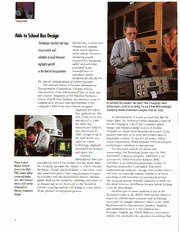
NASA Technical Reports Server (NTRS) 20020086372: Aids to School Bus Design PDF
Preview NASA Technical Reports Server (NTRS) 20020086372: Aids to School Bus Design
Aids to Schod Bus Design Technology transfers that help Historically, a school bus chassis was nothing ossure safety and more than a medium truck chassis. However, reliobiliw in pupil transport escalating parent demands for maximum highlight spinofs safety and reliability prompted some in the field of tronsportotion manufacturers to introduce chassis designed specifically for the special considerations of school transport. The industry leader is Navistar International Transportation Corporation, Chicago, Illinois, manufacturer of the InternationalBl ine of truck and ~ - - ~ bus chassis. Engineers at the Navistar Technical Center, Fort Wa.y ne., Indiana, devoted two vears of sophisticated research and development to'the An instrument that evoluotes "ride quality" (box in foreground) awaits company's 3000 Series Bus Chassis, designed loading aboard a school bus for testing. It is one of three NASA technologies expressly for school employed by Navistor lnternotionol in designing school bus chassis. bus applications. The I first of this series was In development of a new product line like the I introduced in 1989; Series 3000, the Technical Center employs a state-of- the latest, the the-art Unigraphic CAD/CAM (computer aided International 3900 FC, design and manufacturing) system. It enables was introduced in designers to create three-dimensional models of the 1991. Design of all of product and each of its parts and subject them to the 3000 Series was exhaustive analysis "to see if it all works" before I aided by NASA actual construction. Three separate NASA-developed technology originally technologies contribute to this process. developed for aviation For structural analysis of chassis and I and space use. components, the Technical Center uses the MSC/ Navistar NASTRANB computer program. NASTRAN is an I International does not acronym for NASA Structural Analysis; MSC/ Shown in use at manufacture school bus bodies. For the Series 3000, NASTRAN is an enhanced proprietary version by Novistor Technical the company provides the chassis - which includes MacNeal-Schwendler Corporation. NASTRAN Center is the SPATE the frame, wheels and powertrain - the hood, cowl mathematically analyzes a design and predicts how it 9000 system (yellow and instrument panel; other manufacturers integrate will hold up under the various conditions of stress scanner and disploy their bodies with the International chassis. Navistar and strain it will encounter in operational service. unit), which measures prides itself on the durability, reliability and safety of The program permits Navistar engineers to study the stress in truck ond bus its chassis, due in no small pan to the Technical structural behavior of different designs before locking components by Center's exacting analysis and testing in every phase in on the final design. detecting temperohre of the product development process. Another type of stress analyzer in use at the changes. Technical Center is the SPATE 9000 system, which is based on infrared stress measurement technology developed by Langley Research Center in the 1960s. Manufactured by Ometron Ltd., London, England, and distributed in the U.S. by Ometron Inc., Herndon, Virginia, the SPATE 9000 is a non-contact system (not attached to the structure it is testing) that The third NASA technology employed by the Technical Center is the Wyle Ride Quality Meter, developed by Langley Research Center as an aid to passenger aircraft design and manufactured under NASA license by Wyle Laboratories, Hampton, Virginia. The meter is a vehicle design aid which assures that passengers get a smooth, comfortable ride by providing an accurate measurement of the "ride quality" of the vehicle being developed, obviating reliance on the imprecise subjective judgments of individuals involved in the test program. Mounted on the vehicle being tested, the Ride Quality Meter employs a package of sensors to measure vibration and a sound level meter to measure noise. The vibration signals are computer processed to get a set of indices representative of the subjective discomfort level produced by vibration. It serves, in effect, as a "passenger jury," advising vehicle developers of the vehicle's ride quality in order that they may improve it if necessary. 1 These technologies are part of a much broader, sophisticated process of design, analysis, test and construction that has made the International line of trucks and buses highly respected and captured for the company an estimated 4548 percent of the total school bus chassis A typical stress display; the black area (center photo) represents the greatest market. Navistar's Pat Gerardot (standing) and les Grundrnan model a temperature change, reflecting the area of greatest stress. school bus hood, using a NASA computer program that predicts where areas of stress may leod to moteriol fatigue. relies on infrared detection of minute temperature Snternational is a registered fluctuations that accompany changes in stress levels. trademark of Navistar The SPATE 9000 includes a scanner and a data International Transportation processing unit with a visual display. The display Company. presents a stress map, in calibrated colors, of parts as small as a pencil or as large as the side of a tractor @'NASTRAN is a registered cab. The data is used for stress measurements, load trademark of the National transfer mechanisms, detection of hidden material Aeronautics and Space flaws, and for monitoring structural changes that Administration. occur during fatigue testing.
